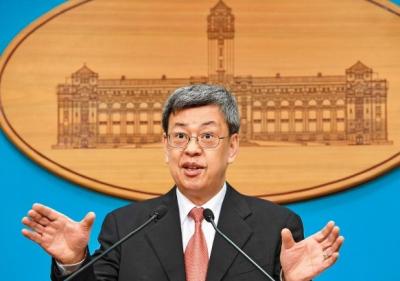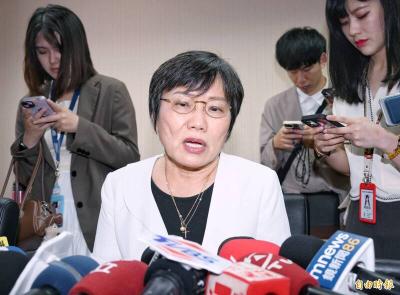More than 60 percent of the respondents to a survey said that “Mainland China” should no longer be designated as the nation’s territory if the Republic of China (ROC) Constitution is amended, the Taiwan Indicators Survey Research said on Thursday.
While amendments to the ROC Constitution considers China, called the “Mainland Area,” and Taiwan, called the “Taiwan Area,” as territories of the ROC, a majority of the respondents said they disagree with the amendments.
According to the results of the survey, 63.5 percent of the respondents said that if the Constitution is to be amended again, clauses stipulating the “Mainland Area” as ROC territory should be removed and 19.8 percent said that it should continue to be designated as territory of the ROC, while 16.6 percent declined to answer the question.
An analysis of the survey results showed that there might also be a generation gap over the issue of whether the “Mainland Area” should continue to be ROC territory, with support for removing the related clause increasing among younger people.
While China repeatedly asks president-elect Tsai Ing-wen (蔡英文) to recognize the so-called “1992 consensus” and China’s Taiwan Affairs Office director Zhang Zhijun (張志軍) says that Tsai’s refusal to recognize the “consensus” would be considered a change in cross-strait “status quo” — despite Tsai’s pledge to maintain it — the majority of the respondents across party lines seem to side with Tsai.
The “1992 consensus” refers to a tacit understanding between the Chinese Nationalist Party (KMT) and the Chinese government that both sides of the Strait acknowledge there is “one China,” with each side having its own interpretation of what “China” means.
Survey results showed that 55.1 percent of the respondents consider it maintaining the “status quo” if Tsai continued to push for cross-strait exchanges under the ROC Constitution and 27.1 percent said they would consider Tsai’s refusal to recognize the “1992 consensus” as changing the “status quo.”
As many as 50 percent of the respondents who identified themselves as pan-blue supporters said they agree with Tsai; the ratio increased to 61.2 percent among pan-green supporters, while 54.3 percent of the respondents who identified themselves as neutral said they support Tsai’s idea.
The survey also showed Tsai is overwhelmingly trusted by the respondents compared with President Ma Ying-jeou (馬英九) and Chinese president Xi Jinping (習近平).
According to the survey, 55 percent of the respondents said they trust Tsai, 26 percent said they do not trust her, 26 percent said they trust Ma and 16 percent said they trust Xi.

Taiwan would welcome the return of Honduras as a diplomatic ally if its next president decides to make such a move, Minister of Foreign Affairs Lin Chia-lung (林佳龍) said yesterday. “Of course, we would welcome Honduras if they want to restore diplomatic ties with Taiwan after their elections,” Lin said at a meeting of the legislature’s Foreign Affairs and National Defense Committee, when asked to comment on statements made by two of the three Honduran presidential candidates during the presidential campaign in the Central American country. Taiwan is paying close attention to the region as a whole in the wake of a

President William Lai (賴清德) has appointed former vice president Chen Chien-jen (陳建仁) to attend the late Pope Francis’ funeral at the Vatican City on Saturday on his behalf, the Ministry of Foreign Affairs said today. The Holy See announced Francis’ funeral would take place on Saturday at 10am in St Peter’s Square. The ministry expressed condolences over Francis’ passing and said that Chen would represent Taiwan at the funeral and offer condolences in person. Taiwan and the Vatican have a long-standing and close diplomatic relationship, the ministry said. Both sides agreed to have Chen represent Taiwan at the funeral, given his Catholic identity and

Chinese Nationalist Party (KMT) Chairman Eric Chu (朱立倫), spokeswoman Yang Chih-yu (楊智伃) and Legislator Hsieh Lung-chieh (謝龍介) would be summoned by police for questioning for leading an illegal assembly on Thursday evening last week, Minister of the Interior Liu Shyh-fang (劉世芳) said today. The three KMT officials led an assembly outside the Taipei City Prosecutors’ Office, a restricted area where public assembly is not allowed, protesting the questioning of several KMT staff and searches of KMT headquarters and offices in a recall petition forgery case. Chu, Yang and Hsieh are all suspected of contravening the Assembly and Parade Act (集會遊行法) by holding

Lawmakers from the Democratic Progressive Party (DPP) yesterday established a friendship group with their counterparts in Ukraine to promote parliamentary exchanges between the two countries. A ceremony in Taipei for the Taiwan-Ukraine Parliamentary Friendship Association, initiated by DPP Legislator Chen Kuan-ting (陳冠廷), was attended by lawmakers and officials, including Deputy Minister of Foreign Affairs Francois Wu (吳志中) and European Economic and Trade Office in Taiwan Director Lutz Gullner. The increasingly dire situation in Ukraine is a global concern, and Taiwan cannot turn its back when the latter is in need of help, as the two countries share many common values and interests,